Based on Recent Inquiries from Treasury & Finance Professionals
Since TIS acquired Cashforce and their suite of cash forecasting and working capital analysis tools in 2022, our experts have spoken with thousands of treasury and finance practitioners regarding the cash forecasting processes and operations they have in place, as well as what their associated pain points and challenges are. As a component of these discussions, our team has also fielded numerous questions from practitioners regarding how the TIS cash forecasting solution can help them unlock additional efficiencies related to accuracy, automation, and analysis.
Due to the frequency with which certain inquiries are received, the following article highlights our responses to the ten most common questions asked by treasury and finance teams regarding the usage and deployment of the TIS cash forecasting solution. The questions are arranged in order of complexity as it relates to the functionality we offer. Our hope is that these responses serve as a guide for understanding exactly how our innovative forecasting solution can be adopted and leveraged.
For interested parties, additional information about our software capabilities, industry use cases, and success stories can be found at the end of this resource.
See How Cash Forecasting & Working Capital Fit into Our Broader CashOptix Suite
1. How were TIS’ cash forecasting tools originally developed?
In 2022, TIS acquired Cashforce, an innovative and industry-leading provider of cash management and forecasting solutions. Starting with its initial creation by Nicolas Christiaen in 2010, this cloud-native and API-enabled solution was designed to provide corporates with strategic insights over their cash positions, forecasts, and overall working capital. The platform was built to support vast amounts of data inputs and forecast methodologies, with extensive processing power enabled by the cloud model. The intention was to build a platform capable of supporting global enterprises that require complex forecast modeling for multiple inputs, sources, and forecast logics, while also delivering a level of flexibility and ease-of-use that suits companies of all sizes.
From the beginning, this flexible model proved very effective in the market and starting in 2018, first through an extensive partnership and followed by an official acquisition, Cashforce’s full suite of capabilities have become integrated with TIS’ existing SaaS-based liquidity, payments, and banking platform. Today, this combined solution now provides over 35,000 treasury and finance professionals with industry-leading benefits surrounding cash visibility, cash flow forecasting, working capital analytics, payments, bank connectivity, and much more.
2. What are the primary benefits of the TIS Cash Forecasting solution?
The TIS Cash Forecasting solution automatically aggregates cash forecasting data sources such as bank balances / transactions, AR / AP invoices, sales forecasts, payroll data, and financial statement information. Corporates can then apply a variety of different assumptions, forecast methodologies, and distribution logics to create a comprehensive projection of anticipated short and long-term cash positions. Forecasts can be evaluated through variance and scenario analyses and reviewed according to any time period. TIS also provides drill down capabilities so that users can view the detail behind specific forecast categories as well as the underlying item level build-up of those forecast categories.
Finally, TIS’ proprietary smart logic analyzes forecasts over time and recommends improvements based on recognized discrepancies between forecasted cash flow timing and historical patterns of actual cash flow timing. All of these capabilities are provided with enhanced analytics and visual reporting features so that users can quickly and easily determine their positions, gain valuable working capital insights, and share outcomes with other departments and business leaders.
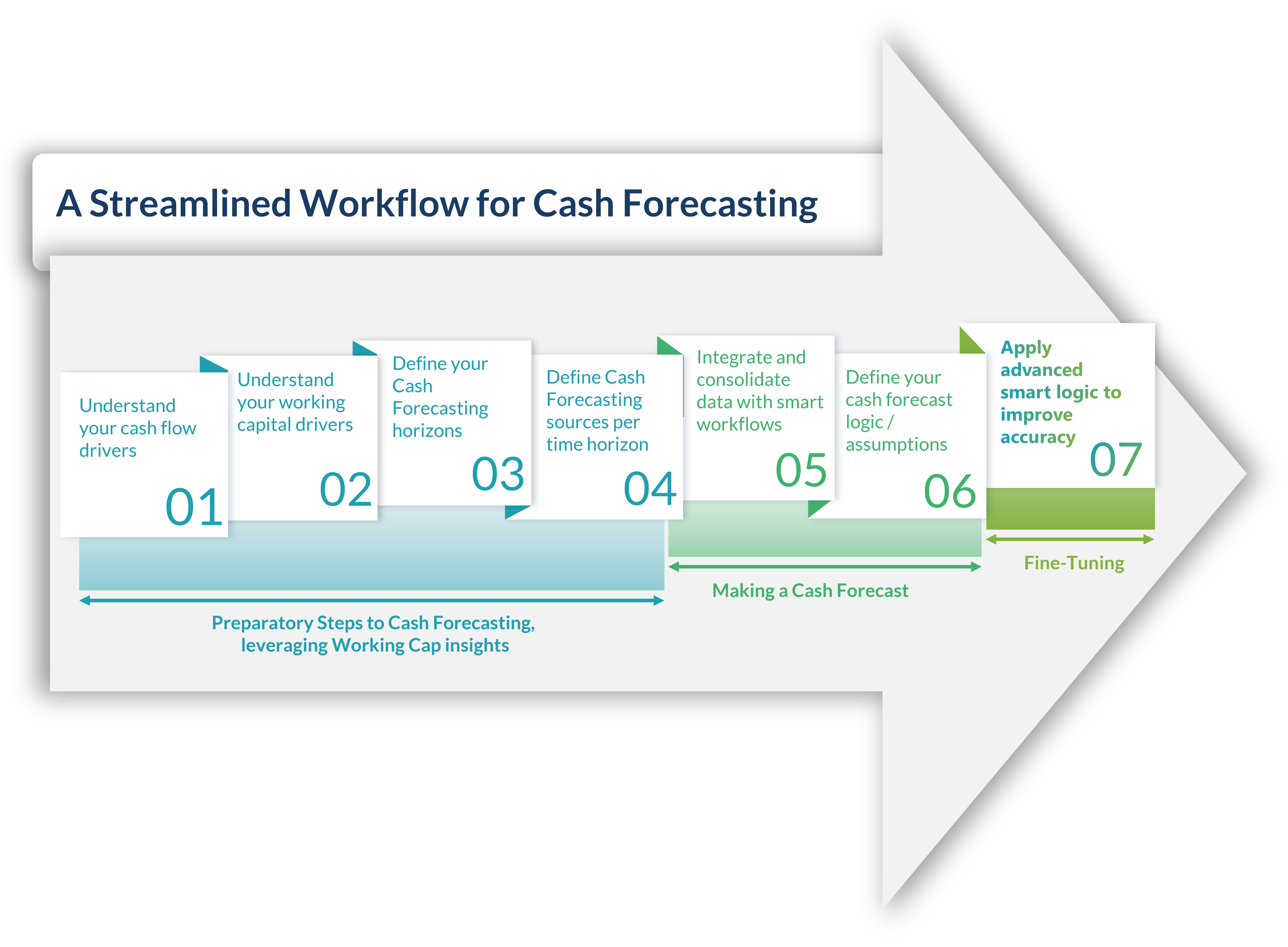
3. What is the composition of companies that currently leverage TIS Cash Forecasting?
Today, companies of all sizes, locations, and states of maturity leverage the TIS cash forecasting and working capital solutions. This includes Fortune 500 companies like Kellogg’s, Unilever, Pearson, TomTom, and Dawn Foods, as well as other reputable organizations including REI, Kimberly Clarke, Hitachi, and more. We support clients operating as non-profits, retailers, logistics firms, manufacturers, automobile, airline, and a host of other segments – all of which have demonstrably benefitted from deploying our solutions.
To make matters easier, the TIS cloud platform is designed to integrate with the full spectrum of back-office ERPs and TMSs, as well as banking portals, and Excel workbooks that companies are working with across different industries, regions, and complexities. This means that regardless of the existing processes, user groups, or inputs required to manage any specific company’s cash forecasting process, the TIS platform can not only support them, but also help them substantially improve over time.
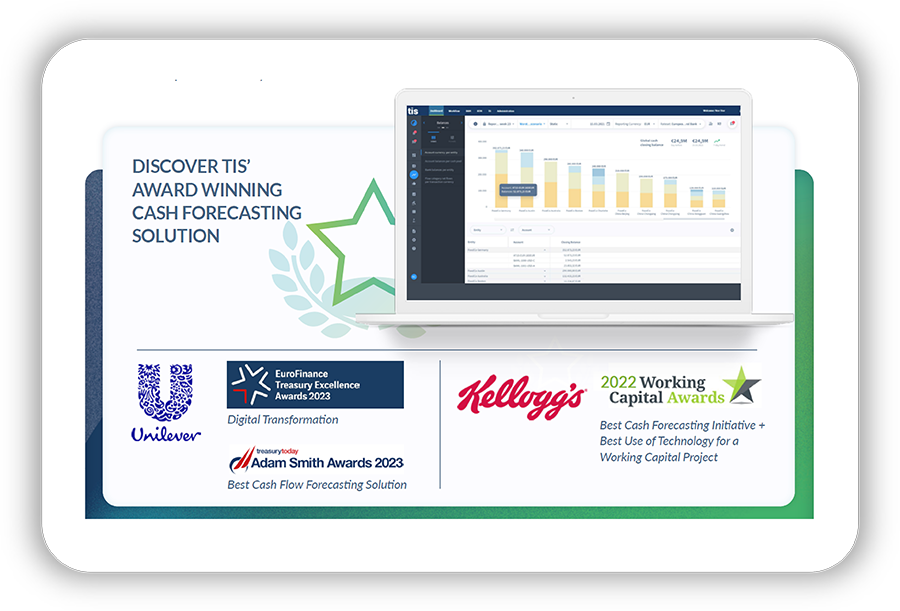
4. What internal stakeholders benefit the most from TIS Cash Forecasting?
Treasurers, CFOs, and finance teams (including FP&A, AP, AR, and accounting) are the main parties that benefit from our cash forecasting solutions, but IT also benefits from simplified implementation and integration responsibilities. For CFOs and Treasurers, TIS enables seamless reporting on global cash forecasts of any timeframe, granularity, or level of focus, from a “global” down to an “invoice” level. This ultimately helps them better identify and prepare financial strategies for anticipated cash surpluses or deficits at the HQ level, as well as for individual entities or divisions. It also helps them better monitor liquidity and working capital, and more efficiently communicate the company’s expected financial position to other stakeholders and board members.
At the same time, FP&A teams can also benefit from our forecasts in this regard, as our “direct” cash forecast data (derived mainly from bank statements and invoices) can support their indirect forecast data to serve as a benchmark and form of reference. And finally, users in AP and AR can leverage our software to analyze vendor payment behaviors and invoicing cycles to better understand working capital drivers, manage supplier financing programs, identify delinquent customer payments, and optimize payment terms and invoicing arrangements.
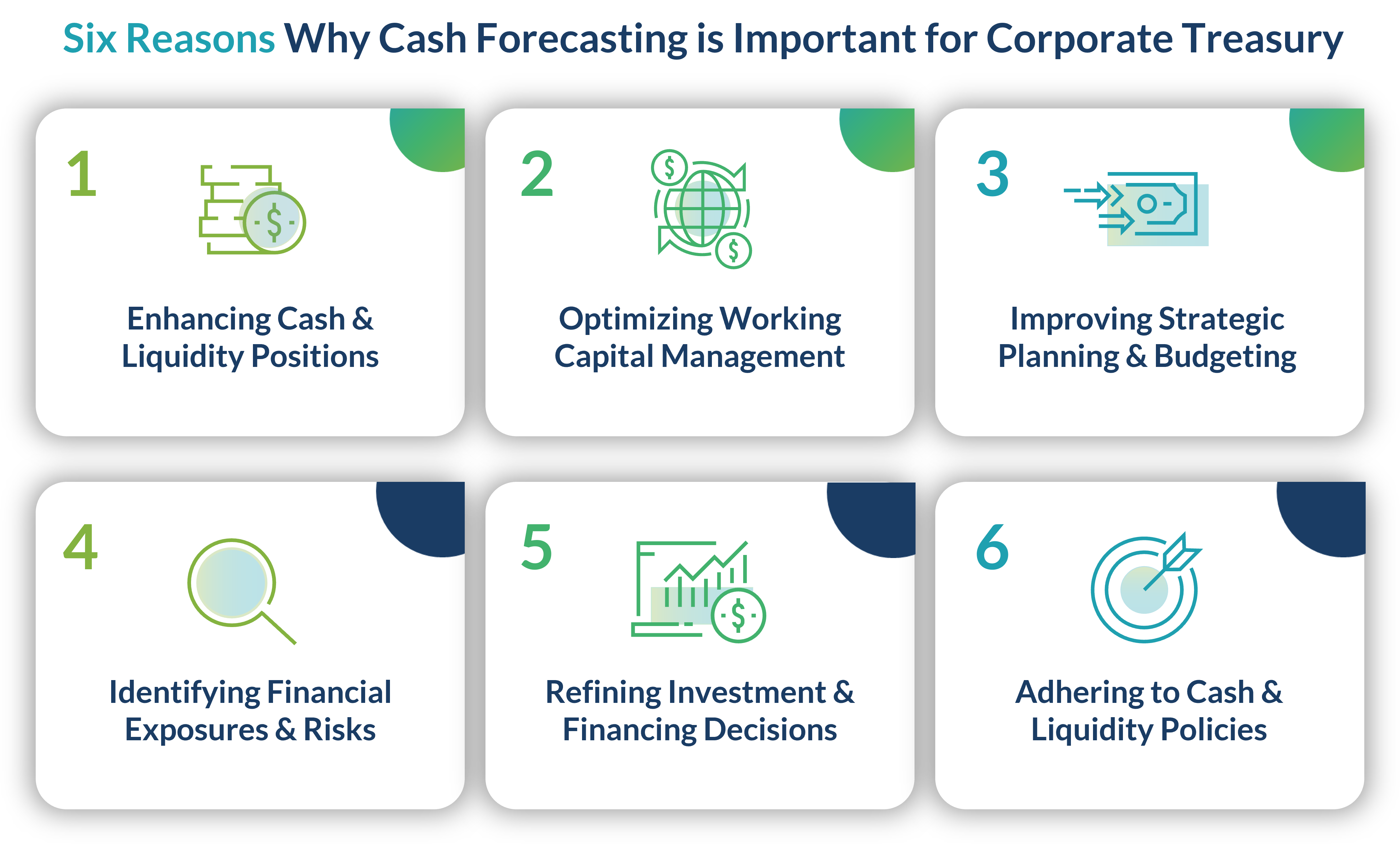
5. What if my company is only using Excel for cash forecasting right now?
TIS leverages an innovative “walk-run-fly” model when onboarding new customers so that our solution can provide the exact level of automation and support needed at each stage of company growth. For some, this means helping aggregate data from excel and bank portals to create more accurate forecasts, while for others, it requires extensive connectivity to numerous ERP, TMS, and banking providers as part of a more sophisticated infrastructure. But regardless of which stage of maturity your company is at, our solution will integrate and accommodate your structure to support your workflows and drive greater accuracy, efficiency, and automation of the forecasting process.
As customer needs evolve over time, TIS provides the ability to progress from a simple “walk” forecasting model to a “run” or “fly” model depending on the scale of complexity that is required to support. Today, we have clients with revenues ranging from $100 million and below to $10 billion and more, and with simple “Excel-only” infrastructures as well as multi-ERP and multi-TMS structures. In each case, TIS is able to tailor our model to support organizations as their needs require, and we maintain the flexibility to help you enhance your usage of our platform over time to continually automate and simplify your cash forecasting methodology.
6. What specific features does TIS Cash Forecasting offer? Does it allow you to create different scenarios, perform variance analysis, adjust variables, and see the impact on your cash flow?
TIS’ cash forecasting software enables users to conduct variance and scenario analysis directly within the system. For variance analysis, actuals can be compared with forecasts across any time horizon, and with drill-down analysis available at the company, entity, vendor, and even invoice level to determine the root-cause of various discrepancies. In addition to performing forecast-to-actual variance analysis, customers also have the ability to perform variance analysis across different versions of their forecast, such as comparing the current forecast against a different version created earlier in the year or comparing a base case forecast vs. a “worst-case” scenario.
For scenario analysis, treasury teams can create unique scenarios – such as for rising interest rates, FX rate changes, delayed customer payments, or rising cash expense categories – and subsequently measure the expected impact on cash flows. The system works so that only treasury may create as many individual scenarios as needed for analysis and evaluate the expected impact of each as they prefer. As these analyses are performed, one major advantage of the TIS system is that we can support large amounts of granular data (invoices, bank statements, etc.) and contributors / users (i.e. from different departments, entities, etc.) as required to support global forecasts. For multibillion dollar companies, this could include dozens of users, as well as tens or even hundreds of thousands of bank statements and invoices. And for smaller but growing companies, it provides the confidence that no matter the scale of your growth, our solution will always be able to accommodate your data and processing needs, and at a scale and scope that matches your requirements.
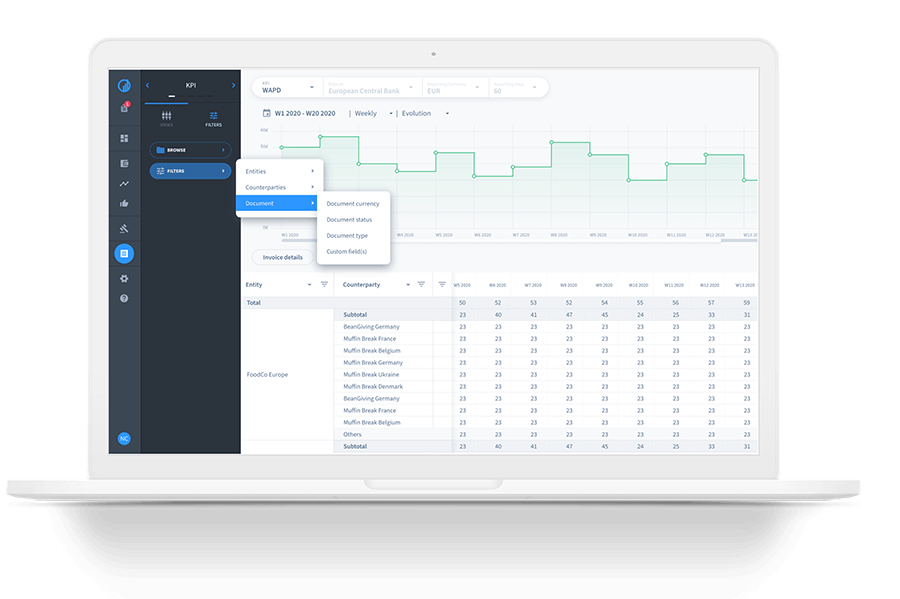
7. What does the data import and aggregation process look like? Does it integrate with your accounting software, bank accounts, and other data sources, as well as with FP&A and other forecast sources?
TIS is fully capable of integrating with ERPs, TMSs, bank portals, and many other fintech and back-office systems to import bank statements, invoices, and other source data directly. At the onset of a new project, treasury will typically be required to help map the required forecasted cash flows to their corresponding data source within TIS, then moving forward, our system will automate the collection and population of this data (i.e. from bank statements and invoices) on a routine basis.
When it comes to forecast frequency, TIS can support the automation of both your short-range and mid-to-long range forecasts. Short range forecast (8-12 weeks) are typically derived from direct forecast inputs, such as open AP / AR invoices, Treasury deal maturities, and payroll data. Mid to long-range forecasts incorporate P&L and other financial data as well as a set of company defined assumptions and forecast logics to extend the forecast out to the company’s desired duration. In addition, manual uploads of these various data sources can be supported. Finally, TIS “direct” cash forecasts can be used to validate the results of FP&A’s long-term indirect forecasts that are based on G/L and P&L statements, typically on a quarterly, semi-annual, or annual basis. For those who may be unfamiliar with direct vs indirect cash forecasting, it’s important to understand the delineation here. For more information, refer to this explanation.
8. How does data manipulation work within the system? Can you upload accrual-level forecasts and set expected payments or receivables timing within the system? Can you adjust these on the fly, and is there any machine learning or AI where the system provides suggestions to improve your forecast?
Yes, users are able to directly upload accrual forecasts and set expected payments and receivables timing in the system. Although users can automate the upload of forecasting inputs and set preferred forecast lengths and horizons, these variables can be adjusted on the fly directly by users as well. Data handling within the system is also highly flexible and intuitive, and parameters regarding the entitlements available for each user or user group can be fully customized.
In addition, TIS’ proprietary smart-logic can evaluate forecast inputs and outputs and identify discrepancies in payment behaviors, supplier invoicing cycles, and other factors to determine the root cause of anomalies or forecast variances. This logic is essential for analyzing large volumes of forecast data and determining the likeliest cause of discrepancies, such as an individual supplier taking longer than normal to pay, certain sets of invoices being delayed, etc.
9. What type of outputs does the system create? Are there examples of reporting, charts, and dashboard outputs?
TIS providers users with a full suite of in-house reporting interfaces, analytics, and dashboards directly within the platform. These dashboards are configurable depending on the preferences of each user (or user group) for viewing forecast variables and metrics by different timeframes, regions, entities, etc.
Within the system, most charts are interactive and feature drill-down toggles that enable users to analyze any specific variable or set of variables, from a “global” level down to an entity, bank, region, or even invoice-specific view. Today, these dashboards can be customized by users to evaluate any cash flow variable, including payment behaviors by region or vendor, as well as invoice cycles, bank account balances, and more. For a tailored walkthrough of the platform, you can request a demo here.
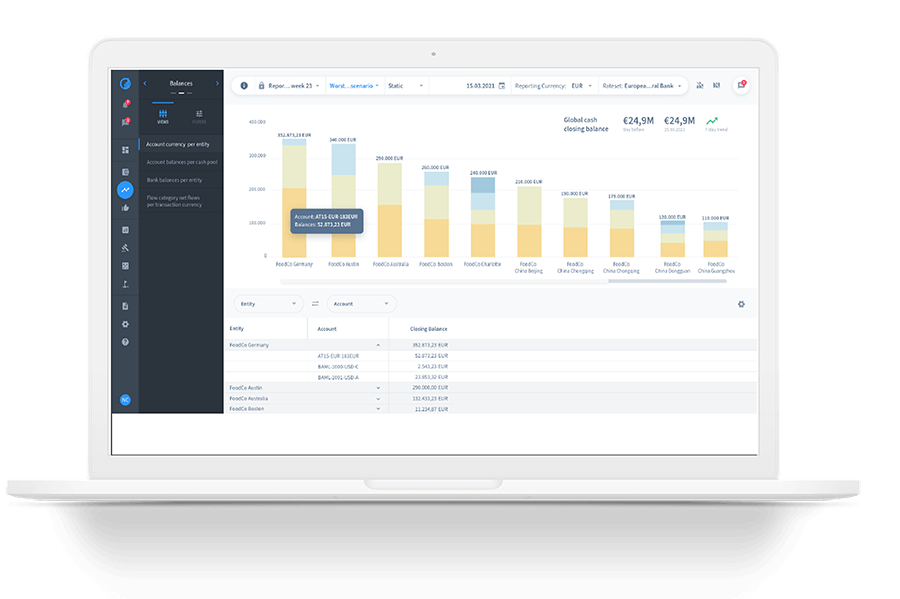
10. Are users analyzing transactions and cash flows primarily based on bank statements and invoices, or are they using other methods?
With regards to coding transactions, a combination of bank statements and invoices are used in most circumstances, which largely depends on the preference(s) of the user groups within the system. In most cases, the upload of these statements and invoices is automated directly from the source system, such as ERPs and TMSs, or various banking portals. However, manual uploads of these data sources are supported as well, such as via Excel, PDF, or other similar formats.
Today, we have many clients that leverage a combination of these various sources, relying on ERPs or TMSs as much as possible and filling in for various entities or units with banking portals or spreadsheets in instances where direct connectivity cannot be supported. In large part, APIs can be used for automated transmission of these statements and invoices between systems, but TIS also provides host-to-host (SFTP) integrations in cases required by the client.
Additional Questions About Onboarding & ROI for TIS Cash Forecasting
11. What does the implementation process look like and how long does it last? What teams are involved, and what is their level of lift?
The implementation process used by TIS is very flexible and can be adjusted based on any company’s internal IT and treasury / finance bandwidth to support the project, and also based on the complexity of their back-office and banking structure. For instance, while companies with a simple back-office and banking infrastructure and with ample IT and treasury availability may be able to streamline their deployment of TIS substantially to just a few weeks or months, while companies with a complex global architecture involving dozens of banks and systems and limited bandwidth may require extensive assistance and a longer roadmap to achieve full deployment.
However, we find that in many cases, organizations are able to go live with the initial stages of their forecasts starting within 4-6 weeks, with additional stages lasting longer depending on the scope. Throughout the process, TIS’ dedicated customer support and onboarding team helps ensure a smooth adoption, and our experts have maintained a 9.2/10 rating on service over the past several years as a result of our proficiency in this regard. TIS also has a proven track record of working with various industry partners – including banks – to provide additional support in cases where clients have complex or time-consuming projects.
12. What general improvements do clients typically see? Is there significant automation or time savings?
Typically, clients that implement TIS cash forecasting are able to automate the core forecast creation process (including routine data aggregation and classification), deviate away from the use of spreadsheets, and ultimately save significant time on forecast creation and upkeep. In place of these tasks, stakeholders can spend more time on strategic analysis of their forecasts, as well as on identifying the best financial strategies to deploy based on their projected cash positions. In addition, many clients that are able to substantially improve forecast accuracy and optimize their overall working capital performance also achieve substantial cost-savings, either from reduced debt and interest expenses, or from revenue earned by more efficiently investing cash in short-term interest products.
Examples of clients who have achieved significant time and cost savings include Kellogg’s, Unilever, Dawn Foods, and Pearson, all of whom have also been recognized through various industry awards for their transformational cash forecasting projects, each of which have helped save millions of dollars annually.
If you’d like to review the case studies associated with any of these clients, refer to the below links.
Get More Info About the TIS Cash Forecasting Solution
Practitioners interested in learning more about TIS’ cash forecasting solutions can refer to the below resources:
-
Cash Forecasting Solutions Page: Click Here
-
Cash Forecasting Product Factsheet: Click Here
-
4 Common Use Cases for TIS Cash Forecasting: Click Here
-
Kellogg’s Award-Winning Cash Forecasting Success Story: Click Here
-
Unilever’s Award-Winning Cash Forecasting Success Story: Click Here
-
Pearson’s Award-Winning Cash Forecasting Success Story: Click Here
-
TomTom’s Cash Forecasting Success Story: Click Here
-
To Schedule a Demo on Cash Forecasting: Click Here
About TIS
TIS helps CFOs, Treasurers, and Finance teams transform their global cash flow, liquidity, and payment functions. Since 2010, our award-winning cloud platform and best-in-class service model have empowered the entire office of the CFO to collaborate more effectively and attain maximum efficiency, automation, and control. By streamlining connectivity between our customers’ back-office systems and their worldwide banks, vendors, and business partners, TIS enables users to achieve superior performance in key areas surrounding cash forecasting, working capital, outbound payments, financial messaging, fraud prevention, payment compliance, and more.
With over 11,000 banking options, $80 billion in daily cash managed, and $2.5 trillion in annual transaction volume, TIS has a proven track record of combining our unparalleled market expertise with tailored client and community feedback to drive digital transformation for companies of all sizes and industries. As a result, hundreds of organizations and thousands of practitioners rely on TIS daily to gain strategic advantage, monetize data, improve operational efficiency, and better manage risk.




